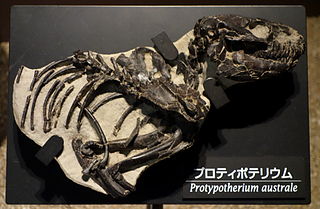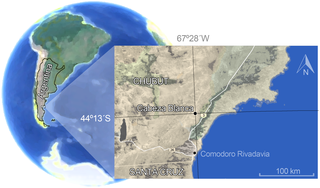
Protypotherium is an extinct genus of notoungulate mammals native to South America during the Oligocene and Miocene epochs. A number of closely related animals date back further, to the Eocene. Fossils of Protypotherium have been found in the Deseadan Fray Bentos Formation of Uruguay, Muyu Huasi and Nazareno Formations of Bolivia, Cura-Mallín and Río Frías Formations of Chile, and Santa Cruz, Salicas, Ituzaingó, Aisol, Cerro Azul, Cerro Bandera, Cerro Boleadoras, Chichinales, Sarmiento and Collón Curá Formations of Argentina.

Cramauchenia is an extinct genus of litoptern South American ungulate. Cramauchenia was named by Florentino Ameghino. The name has no literal translation. Instead, it is an anagram of the name of a related genus Macrauchenia. This genus was initially discovered in the Sarmiento Formation in the Chubut Province, in Argentina, and later it was found in the Chichinales Formation in the Río Negro Province and the Cerro Bandera Formation in Neuquén, also in Argentina, in sediments assigned to the SALMA Colhuehuapian, as well as the Agua de la Piedra Formation in Mendoza, in sediments dated to the Deseadan. In 1981 Soria made C. insolita a junior synonym of C. normalis. A specimen of C. normalis was described in 2010 from Cabeza Blanca in the Sarmiento Formation, in sediments assigned to the Deseadan SALMA.
The Neoepiblemidae are an extinct family of hystricognath rodents from South America. The genera Dabbenea and Perumys are now included in Phoberomys. The delineation between Neoepiblemidae and Dinomyidae has historically been unclear, with some genera having varying taxonomic placement. A 2017 study found Phoberomys to be part of the group, while Eusigmomys was found to be part of the Dinomyidae.

Cephalomyidae is an extinct family of caviomorph rodents from South America. The specific relationships of the family are uncertain, and affinities to both chinchilloid and cavioid rodents have been supported. Most recently, Kramarz in 2005 performed a phylogenetic analysis supporting a relationship to the Cavioidea, as represented by Eocardiidae, although more recent analyses have placed them among the chinchilloids as relatives of the giant neoepiblemid rodents. McKenna and Bell (1997) questioned the validity of the family, placing the cephalomyid genera then known in Dasyproctidae, but Kramarz (2001) subsequently reasserted the distinctiveness of cephalomyids.
The South American land mammal ages (SALMA) establish a geologic timescale for prehistoric South American fauna beginning 64.5 Ma during the Paleocene and continuing through to the Late Pleistocene. These periods are referred to as ages, stages, or intervals and were established using geographic place names where fossil materials where obtained.
The Casamayoran age is a period of geologic time within the Early Eocene epoch of the Paleogene, used more specifically within the South American land mammal age (SALMA) classification. It follows the Itaboraian and precedes the Mustersan age.
The Divisaderan age is a South American land mammal age, covering a period of geologic time within the Middle and Late Eocene epochs of the Paleogene. It follows the Mustersan age and is followed by the Tinguirirican age.
The Tinguirirican age is a period of geologic time within the Late Eocene and Early Oligocene epochs of the Paleogene, used more specifically within the SALMA classification in South America. It follows the Divisaderan and precedes the Deseadan age.
The Deseadan age is a period of geologic time within the Oligocene epoch of the Paleogene to the Early Miocene epoch of the Neogene, used more specifically within the SALMA classification of South America. It follows the Tinguirirican and precedes the Colhuehuapian age.
The Colhuehuapian age is a period of geologic time within the Early Miocene epoch of the Neogene, used more specifically within the SALMA classification in South America. It follows the Deseadan and precedes the Santacrucian age.

Astrapotheriidae is an extinct family of herbivorous South American land mammals that lived from the Late Eocene to the Middle Miocene 37.71 to 15.98 million years ago. The most derived of the astrapotherians, they were also the largest and most specialized mammals in the Tertiary of South America. There are two sister taxa: Eoastrapostylopidae and Trigonostylopidae.
Comahuetherium is an extinct genus of astrapotherian mammal from the Early Miocene. It is a basal astrapotheriid which lived in what is now Patagonia, Argentina. The holotype was found in the Cerro Bandera Formation in Neuquén Province, northern Patagonia and additional specimens were found at the Gran Barranca south of Lake Colhué Huapi, in Chubut Province of central Patagonia. It was first named by Alejandro Kramarz and Mariano Bond in 2011 and the type species is Comahuetherium coccaorum.
This paleomammalogy list records new fossil mammal taxa that were described during the year 2010, as well as notes other significant paleomammalogy discoveries and events which occurred during that year.

The Golfo San Jorge Basin is a hydrocarbon-rich sedimentary basin located in eastern Patagonia, Argentina. The basin covers the entire San Jorge Gulf and an inland area west of it, having one half located in Santa Cruz Province and the other in Chubut Province. The northern boundary of the basin is the North Patagonian Massif while the Deseado Massif forms the southern boundary of the basin. The basin has largely developed under condition of extensional tectonics, including rifting.
The Agua de la Piedra Formation is a Late Oligocene geologic formation of the Malargüe Group that crops out in the southernmost Precordillera and northernmost Neuquén Basin in southern Mendoza Province, Argentina.

The Sarmiento Formation, in older literature described as the Casamayor Formation, is a geological formation in Chubut Province, Argentina, in central Patagonia, which spans around 30 million years from the mid-Eocene to the early Miocene. It predominantly consists of pyroclastic deposits, which were deposited in a semi-arid environment. It is divided up into a number of members. The diverse fauna of the Sarmiento Formation, including a variety of birds, crocodilians, turtles and snakes, also includes many mammals such as South American native ungulates as well as armadillos, and caviomorph rodents.
The Chichinales Formation is a geological formation in Río Negro Province, Argentina which dates from the Late Oligocene to the Early Miocene, around 23 to 17.5 million years ago. It predominantly consists of pyroclastic deposits, which were deposited in a semi-arid environment. It is divided up into a number of members. The diverse fauna of the Chichinales Formation, including a variety of turtles and birds, also includes many mammals such as South American native ungulates as well as armadillos, and caviomorph rodents.
Australoprocta is an extinct genus of dasyproctid rodent that lived during the Early Miocene of what is now Argentina. Fossils of this genus have been found in the Chichinales and Sarmiento Formations of Argentina.

Perimys is an extinct genus of neoepiblemid rodent that lived from the Early to Late Miocene in what is now South America. Fossils have been found in the Cerro Bandera, Cerro Boleadoras, Ituzaingó, Santa Cruz, and Sarmiento Formations of Argentina, and the Galera, Santa Cruz and Río Frías Formations of Chile.
Incamys is an extinct genus of chinchillid rodent that lived during the Late Oligocene (Deseadan) in what is now South America. Fossils of this genus have been found in the Salla Formation of Bolivia and the Agua de la Piedra and Sarmiento Formations of Argentina. Research on endocasts suggest their were group living using call communication like modern chinchillas.





